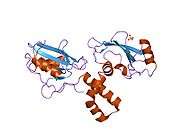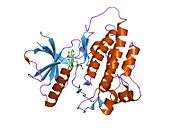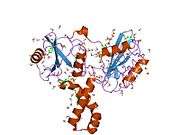ZAP70
ZAP-70 (Zeta-chain-associated protein kinase 70) is a protein normally expressed near the surface membrane of T cells and natural killer cells. It is part of the T cell receptor, and plays a critical role in T-cell signaling. Its molecular weight is 70 kDa, and it is a member of the protein-tyrosine kinase family.
Clinical significance
ZAP-70 in B cells is used as a prognostic marker in identifying different forms of chronic lymphocytic leukemia (CLL). DNA analysis has distinguished two major types of CLL, with different survival times. CLL that is positive for the marker ZAP-70 has an average survival of 8 years. CLL that is negative for ZAP-70 has an average survival of more than 25 years. Many patients, especially older ones, with slowly progressing disease can be reassured and may not need any treatment in their lifetimes.[5]
In systemic lupus erythematosus, the Zap-70 receptor pathway is missing and Syk takes its place.[6]
ZAP70 deficiency results in a form of immune deficiency.
Function
T lymphocytes are activated by engagement of the T cell receptor with processed antigen fragments presented by professional antigen presenting cells (i.e. macrophages, dendritic cells and B cells) via the MHC. Upon this activation, the TCR co-receptor CD4 or CD8 binds to the MHC, activating the co-receptor associated tyrosine kinase Lck. Lck phosphorylates the intracellular portions of the CD3 complex (called ITAMs), creating a docking site for ZAP-70. The most important member of the CD3 family is CD3-zeta, to which ZAP-70 binds (hence the abbreviation). The tandem SH2-domains of ZAP-70 are engaged by the doubly phosphorylated ITAMs of CD3-zeta, which positions ZAP-70 to phosphorylate the transmembrane protein linker of activated T cells (LAT). Phosphorylated LAT, in turn, serves as a docking site to which a number of signalling proteins bind including SLP-76. SLP-76 is also phosphorylated by ZAP-70, which requires its activation by Src family kinases.[7] The final outcome of T cell activation is the transcription of several gene products which allow the T cells to differentiate, proliferate and secrete a number of cytokines.
Interactions
ZAP-70 has been shown to interact with:
References
- GRCh38: Ensembl release 89: ENSG00000115085 - Ensembl, May 2017
- GRCm38: Ensembl release 89: ENSMUSG00000026117 - Ensembl, May 2017
- "Human PubMed Reference:". National Center for Biotechnology Information, U.S. National Library of Medicine.
- "Mouse PubMed Reference:". National Center for Biotechnology Information, U.S. National Library of Medicine.
- Chiorazzi N, Rai KR, Ferrarini M (February 2005). "Chronic lymphocytic leukemia". The New England Journal of Medicine. 352 (8): 804–15. doi:10.1056/NEJMra041720. PMID 15728813.
- NEJM 365:2110
- Fasbender F, Claus M, Wingert S, Sandusky M, Watzl C (2017-07-07). "Differential Requirements for Src-Family Kinases in SYK or ZAP70-Mediated SLP-76 Phosphorylation in Lymphocytes". Frontiers in Immunology. 8: 789. doi:10.3389/fimmu.2017.00789. PMC 5500614. PMID 28736554.
- Lupher ML, Reedquist KA, Miyake S, Langdon WY, Band H (September 1996). "A novel phosphotyrosine-binding domain in the N-terminal transforming region of Cbl interacts directly and selectively with ZAP-70 in T cells". The Journal of Biological Chemistry. 271 (39): 24063–8. doi:10.1074/jbc.271.39.24063. PMID 8798643.
- Meng W, Sawasdikosol S, Burakoff SJ, Eck MJ (March 1999). "Structure of the amino-terminal domain of Cbl complexed to its binding site on ZAP-70 kinase". Nature. 398 (6722): 84–90. doi:10.1038/18050. PMID 10078535.
- Han J, Kori R, Shui JW, Chen YR, Yao Z, Tan TH (December 2003). "The SH3 domain-containing adaptor HIP-55 mediates c-Jun N-terminal kinase activation in T cell receptor signaling". The Journal of Biological Chemistry. 278 (52): 52195–202. doi:10.1074/jbc.M305026200. PMID 14557276.
- Neumeister EN, Zhu Y, Richard S, Terhorst C, Chan AC, Shaw AS (June 1995). "Binding of ZAP-70 to phosphorylated T-cell receptor zeta and eta enhances its autophosphorylation and generates specific binding sites for SH2 domain-containing proteins". Molecular and Cellular Biology. 15 (6): 3171–8. doi:10.1128/mcb.15.6.3171. PMC 230549. PMID 7760813.
- Pelosi M, Di Bartolo V, Mounier V, Mège D, Pascussi JM, Dufour E, Blondel A, Acuto O (May 1999). "Tyrosine 319 in the interdomain B of ZAP-70 is a binding site for the Src homology 2 domain of Lck". The Journal of Biological Chemistry. 274 (20): 14229–37. doi:10.1074/jbc.274.20.14229. PMID 10318843.
- Thome M, Duplay P, Guttinger M, Acuto O (June 1995). "Syk and ZAP-70 mediate recruitment of p56lck/CD4 to the activated T cell receptor/CD3/zeta complex". The Journal of Experimental Medicine. 181 (6): 1997–2006. doi:10.1084/jem.181.6.1997. PMC 2192070. PMID 7539035.
- Paz PE, Wang S, Clarke H, Lu X, Stokoe D, Abo A (June 2001). "Mapping the Zap-70 phosphorylation sites on LAT (linker for activation of T cells) required for recruitment and activation of signalling proteins in T cells". The Biochemical Journal. 356 (Pt 2): 461–71. doi:10.1042/bj3560461. PMC 1221857. PMID 11368773.
- Perez-Villar JJ, Whitney GS, Sitnick MT, Dunn RJ, Venkatesan S, O'Day K, Schieven GL, Lin TA, Kanner SB (August 2002). "Phosphorylation of the linker for activation of T-cells by Itk promotes recruitment of Vav". Biochemistry. 41 (34): 10732–40. doi:10.1021/bi025554o. PMID 12186560.
- Lindholm CK, Henriksson ML, Hallberg B, Welsh M (July 2002). "Shb links SLP-76 and Vav with the CD3 complex in Jurkat T cells". European Journal of Biochemistry. 269 (13): 3279–88. doi:10.1046/j.1432-1033.2002.03008.x. PMID 12084069.
- Pacini S, Ulivieri C, Di Somma MM, Isacchi A, Lanfrancone L, Pelicci PG, Telford JL, Baldari CT (August 1998). "Tyrosine 474 of ZAP-70 is required for association with the Shc adaptor and for T-cell antigen receptor-dependent gene activation". The Journal of Biological Chemistry. 273 (32): 20487–93. doi:10.1074/jbc.273.32.20487. PMID 9685404.
Further reading
- Chan AC, Iwashima M, Turck CW, Weiss A (November 1992). "ZAP-70: a 70 kd protein-tyrosine kinase that associates with the TCR zeta chain". Cell. 71 (4): 649–62. doi:10.1016/0092-8674(92)90598-7. PMID 1423621.
- Deindl S, Kadlecek TA, Brdicka T, Cao X, Weiss A, Kuriyan J (May 2007). "Structural basis for the inhibition of tyrosine kinase activity of ZAP-70". Cell. 129 (4): 735–46. doi:10.1016/j.cell.2007.03.039. PMID 17512407.
- Orchard J, Ibbotson R, Best G, Parker A, Oscier D (December 2005). "ZAP-70 in B cell malignancies". Leukemia & Lymphoma. 46 (12): 1689–98. doi:10.1080/09638280500260079. PMID 16263570.
- Hamblin AD, Hamblin TJ (December 2005). "Functional and prognostic role of ZAP-70 in chronic lymphocytic leukaemia". Expert Opinion on Therapeutic Targets. 9 (6): 1165–78. doi:10.1517/14728222.9.6.1165. PMID 16300468.
- Chan AC, Iwashima M, Turck CW, Weiss A (November 1992). "ZAP-70: a 70 kd protein-tyrosine kinase that associates with the TCR zeta chain". Cell. 71 (4): 649–62. doi:10.1016/0092-8674(92)90598-7. PMID 1423621.
- Goldman F, Jensen WA, Johnson GL, Heasley L, Cambier JC (October 1994). "gp120 ligation of CD4 induces p56lck activation and TCR desensitization independent of TCR tyrosine phosphorylation". Journal of Immunology. 153 (7): 2905–17. PMID 7522245.
- Isakov N, Wange RL, Burgess WH, Watts JD, Aebersold R, Samelson LE (January 1995). "ZAP-70 binding specificity to T cell receptor tyrosine-based activation motifs: the tandem SH2 domains of ZAP-70 bind distinct tyrosine-based activation motifs with varying affinity". The Journal of Experimental Medicine. 181 (1): 375–80. doi:10.1084/jem.181.1.375. PMC 2191847. PMID 7528772.
- Nel AE, Gupta S, Lee L, Ledbetter JA, Kanner SB (August 1995). "Ligation of the T-cell antigen receptor (TCR) induces association of hSos1, ZAP-70, phospholipase C-gamma 1, and other phosphoproteins with Grb2 and the zeta-chain of the TCR". The Journal of Biological Chemistry. 270 (31): 18428–36. doi:10.1074/jbc.270.31.18428. PMID 7629168.
- Negishi I, Motoyama N, Nakayama K, Nakayama K, Senju S, Hatakeyama S, Zhang Q, Chan AC, Loh DY (August 1995). "Essential role for ZAP-70 in both positive and negative selection of thymocytes". Nature. 376 (6539): 435–8. doi:10.1038/376435a0. PMID 7630421.
- Mustelin T, Williams S, Tailor P, Couture C, Zenner G, Burn P, Ashwell JD, Altman A (April 1995). "Regulation of the p70zap tyrosine protein kinase in T cells by the CD45 phosphotyrosine phosphatase". European Journal of Immunology. 25 (4): 942–6. doi:10.1002/eji.1830250413. PMID 7737297.
- Neumeister EN, Zhu Y, Richard S, Terhorst C, Chan AC, Shaw AS (June 1995). "Binding of ZAP-70 to phosphorylated T-cell receptor zeta and eta enhances its autophosphorylation and generates specific binding sites for SH2 domain-containing proteins". Molecular and Cellular Biology. 15 (6): 3171–8. doi:10.1128/mcb.15.6.3171. PMC 230549. PMID 7760813.
- Katzav S, Sutherland M, Packham G, Yi T, Weiss A (December 1994). "The protein tyrosine kinase ZAP-70 can associate with the SH2 domain of proto-Vav". The Journal of Biological Chemistry. 269 (51): 32579–85. PMID 7798261.
- Schumann G, Dasgupta JD (September 1994). "Specificity of signal transduction through CD16, TCR-CD3 and BCR receptor chains containing the tyrosine-associated activation motif". International Immunology. 6 (9): 1383–92. doi:10.1093/intimm/6.9.1383. PMID 7819147.
- Watts JD, Affolter M, Krebs DL, Wange RL, Samelson LE, Aebersold R (November 1994). "Identification by electrospray ionization mass spectrometry of the sites of tyrosine phosphorylation induced in activated Jurkat T cells on the protein tyrosine kinase ZAP-70". The Journal of Biological Chemistry. 269 (47): 29520–9. PMID 7961936.
- Ku G, Malissen B, Mattei MG (1994). "Chromosomal location of the Syk and ZAP-70 tyrosine kinase genes in mice and humans". Immunogenetics. 40 (4): 300–2. doi:10.1007/BF00189976. PMID 8082894.
- Chan AC, van Oers NS, Tran A, Turka L, Law CL, Ryan JC, Clark EA, Weiss A (May 1994). "Differential expression of ZAP-70 and Syk protein tyrosine kinases, and the role of this family of protein tyrosine kinases in TCR signaling". Journal of Immunology. 152 (10): 4758–66. PMID 8176201.
- Elder ME, Lin D, Clever J, Chan AC, Hope TJ, Weiss A, Parslow TG (June 1994). "Human severe combined immunodeficiency due to a defect in ZAP-70, a T cell tyrosine kinase". Science. 264 (5165): 1596–9. doi:10.1126/science.8202712. PMID 8202712.
- Chan AC, Kadlecek TA, Elder ME, Filipovich AH, Kuo WL, Iwashima M, Parslow TG, Weiss A (June 1994). "ZAP-70 deficiency in an autosomal recessive form of severe combined immunodeficiency". Science. 264 (5165): 1599–601. doi:10.1126/science.8202713. PMID 8202713.
- Wange RL, Malek SN, Desiderio S, Samelson LE (September 1993). "Tandem SH2 domains of ZAP-70 bind to T cell antigen receptor zeta and CD3 epsilon from activated Jurkat T cells". The Journal of Biological Chemistry. 268 (26): 19797–801. PMID 8366117.
- Huby RD, Carlile GW, Ley SC (December 1995). "Interactions between the protein-tyrosine kinase ZAP-70, the proto-oncoprotein Vav, and tubulin in Jurkat T cells". The Journal of Biological Chemistry. 270 (51): 30241–4. doi:10.1074/jbc.270.51.30241. PMID 8530437.
- Plas DR, Johnson R, Pingel JT, Matthews RJ, Dalton M, Roy G, Chan AC, Thomas ML (May 1996). "Direct regulation of ZAP-70 by SHP-1 in T cell antigen receptor signaling". Science. 272 (5265): 1173–6. doi:10.1126/science.272.5265.1173. PMID 8638162.
- Bubeck Wardenburg J, Fu C, Jackman JK, Flotow H, Wilkinson SE, Williams DH, Johnson R, Kong G, Chan AC, Findell PR (August 1996). "Phosphorylation of SLP-76 by the ZAP-70 protein-tyrosine kinase is required for T-cell receptor function". The Journal of Biological Chemistry. 271 (33): 19641–4. doi:10.1074/jbc.271.33.19641. PMID 8702662.
External links
- GeneReviews/NIH/NCBI/UW entry on ZAP70-Related Severe Combined Immunodeficiency
- ZAP-70+Protein at the US National Library of Medicine Medical Subject Headings (MeSH)









